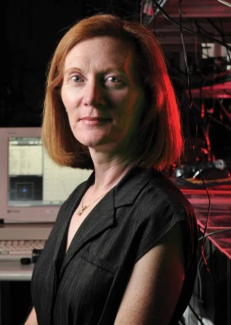Margaret Murnane has been awarded the 2017 Optical Society of America’s (OSA’s) Frederic Ives Medal/Quinn Prize. The award recognizes overall distinction in optics and is the highest award given by OSA. The award was given to Murnane “for pioneering and sustained contributions to ultrafast science ranging from femtosecond lasers to soft x-ray high-harmonic generation to attosecond studies of atoms, molecules, and surfaces.”
Murnane is the first woman to receive this Medal in its nearly 90-year history.
As the 2017 medalist, Murnane has been asked to present a plenary address at OSA’s Annual Meeting, to be held September 17–21 at the Washington Hilton in Washington, DC.
The Frederic Ives Medal was endowed in 1928 by Herbert E. Ives, a distinguished charter member and OSA president in 1924 and 1925. The award is named for his father, Frederic Ives, who invented modern photoengraving and made pioneering contributions to color photography, three-color process printing, and other branches of applied optics. The prize is now funded by the Jarus W. Quinn Ives Medal Endowment, which was raised by OSA members at the time of Quinn’s retirement in recognition of his 25 years of service as OSA’s first Executive Director.



 The Physics Frontiers Centers (PFC) program supports university-based centers and institutes where the collective efforts of a larger group of individuals can enable transformational advances in the most promising research areas. The program is designed to foster major breakthroughs at the intellectual frontiers of physics by providing needed resources such as combinations of talents, skills, disciplines, and/or specialized infrastructure, not usually available to individual investigators or small groups, in an environment in which the collective efforts of the larger group can be shown to be seminal to promoting significant progress in the science and the education of students. PFCs also include creative, substantive activities aimed at enhancing education, broadening participation of traditionally underrepresented groups, and outreach to the scientific community and general public.
The Physics Frontiers Centers (PFC) program supports university-based centers and institutes where the collective efforts of a larger group of individuals can enable transformational advances in the most promising research areas. The program is designed to foster major breakthroughs at the intellectual frontiers of physics by providing needed resources such as combinations of talents, skills, disciplines, and/or specialized infrastructure, not usually available to individual investigators or small groups, in an environment in which the collective efforts of the larger group can be shown to be seminal to promoting significant progress in the science and the education of students. PFCs also include creative, substantive activities aimed at enhancing education, broadening participation of traditionally underrepresented groups, and outreach to the scientific community and general public.